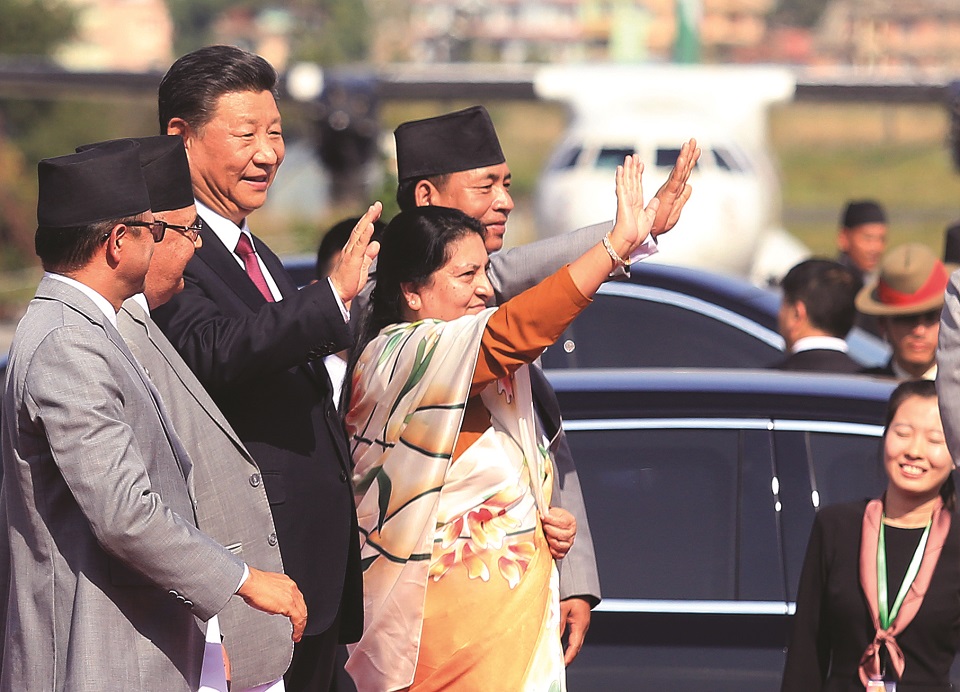
OR


Gopal Thapa
The author is Former Chief of Protocol, Ministry of Foreign Affairsnews@myrepublica.com
Chinese President Xi Jinping returned home on October 13 wrapping up his two-day state visit to Nepal. The visit is now being reviewed and evaluated from different angles by the experts in terms of its impacts on reshaping bilateral relations in tune with the emerging needs. Undoubtedly, the visit of the head of state from as close and powerful a neighbor as China after a hiatus of 23 years was of great historic value. Quite naturally, it evoked great expectations and enthusiasm in Nepal.
The last Chinese President to visit Nepal was Jiang Zemin some 23 years ago. The socio-economic profile of China has since changed beyond recognition. China of today is a far cry from what it used to be then. Because of the stupendous progress in the economic, scientific and technological areas it has now become one of the most influential global power players. It is on the verge of becoming the number one global super power soon, surpassing the United States of America. The incredible technological and resource capability that it commands now has the potential to annihilate geographical distance and barriers even in the remotest corners of the world. Its technological prowess can easily tame the mighty Himalayas in our north, once thought impassable and impregnable. This capability has raised the possibility of connecting our two countries with cross-border highways and railway links. It was hoped the visit would be instrumental in reaching an agreement to draw up a clear roadmap for the launching of a much-hyped trans-Himalayan railway to connect the lands of both countries. It was the expectation that the visit would help render the possibility of transforming Nepal from ‘land-locked’ to a ‘land-linked’ country into reality.
Achievements and ambiguities
There are mixed reactions to the achievements of the visit. The President did make commitment to helping Nepal transform into a ‘land-linked’ country. This commitment holds profound significance. However, there was no solid framework agreement reached, particularly in the financing modalities to translate that vision into reality. Contrary to our expectation, only the agreement to conduct feasibility study on Nepal-China cross-border railway project was reached. Then the finalization of DPR will follow. Only after completion of these two stages and based on the recommendations will the negotiations on financing modalities be set into motion. Thus we have miles to go.
Lack of framework agreement in this regard is clearly disappointing. This was a great opportunity to create an enduring model of Nepal-China relations. This was missed. This is especially so, as the Chinese President visiting us again in the foreseeable future is almost unthinkable. Some say our negotiating team was perhaps unable to convince their Chinese counterparts to secure their consent. But that is a baseless allegation. Our side may have done their best to get at least a framework agreement done on the financing modalities. They may have been certainly knowledgeable of the fact that once the framework agreement was reached, Nepal could have waited until such a time as the feasibility report and the DPR were ready. This would have obviated for us the need to engage in a long and complex negotiation process in the future. But the Chinese side had seemingly other interests in mind.
In this context, some analysts have rightly observed that the first phase of aggressive Chinese investment having been over, it has now entered a new phase where its decisions are made only after a careful, comprehensive and calculated cost-benefit analyses. Hence, they are seemingly not in as much haste as we are, to have that deal done. They think China’s commercial eyes are perhaps set on the vast markets in Bihar, Uttar Pradesh and West Bengal of India. They wouldn’t have consented to ink the framework agreement on financing modalities however much we had wanted them to, it is argued. They preferred to wait until such times as they could take India into confidence.
The first ambiguity involves with respect to the reported news coverage by some media outlets on the agreement to conduct the feasibility study for Kerung-Tokha highway tunnel. It is also reported that China has agreed to build the 40 kilometers long highway tunnels under the Chinese grant assistance. But the press release of Nepal’s Foreign Ministry is silent about this. So, there is confusion about the authenticity of this news. Our foreign ministry needs to clarify.
Again, the real leitmotif of the agreement on elevating our bilateral relations to the strategic partnership level is also ambiguous, in the absence of clarification. In the conduct of international relations, strategic partnership is interpreted, defined and applied depending upon convenience of countries. One does not know what actually are the differences between strategic partnership and comprehensive friendship that defined our relationships earlier. Against these backdrops, some China observers think the visit was more of symbolic significance than of substantive achievement. Others view the visit as highly successful as far as delineating the future course of Nepal-China bilateral relations is concerned. They believe Chinese President’s pledge to help Nepal transform into a land-linked country is the biggest substantive achievement of the visit. They think that this is no small commitment and that a leader of his stature seldom makes such profound commitment for nothing. He will surely keep his promise to make that dream of Nepal come true, sooner than later, they add.
High on substance
High-level exchanges are important features of inter-state relations management. This is more so between the close neighbors. High-level visits undertaken on a regular basis do nourish the roots of relations and help build confidence and cordiality. These are also opportunities to renew, rebuild and reinforce relations to keep them abreast of the contemporary international relations realities. Hence, such important visits should not be measured in terms of short-term benefits only. These should be understood as exercises undertaken more for building better relations for longer term benefits than short-term gains. We have not had any Chinese president visiting us for a long time. We were wondering why China, a close and reliable friend of ours that has always stood in our favor in times of distress, took such a long time to come. Naturally, the visit was bound to create curiosity, excitement and expectations among people in Nepal.
I think the recent state visit of Chinese President should be seen on this light. Without a shadow of doubt, his visit is of far-reaching significance, both in symbols and substance. It has, among others, helped impart a new dynamism to our bilateral ties. Our bilateral relations, in my personal view, have now entered the real substantive phase. The visit, therefore, is of historic value. Now, it remains to be seen how well our government prepares the ground for effective bilateral negotiations to be able to begin the implementation of some of the very substantive infrastructure connectivity projects for us in the days ahead.
The ball is in our court now.
The author is former Chief of Protocol, Ministry of Foreign Affairs
bhimsen29@gmail.com
You May Like This

Chinese President Xi Jinping leaves Chennai for Kathmandu
KATHMANDU, Oct 12: Chinese President Xi Jinping has left Chennai, India for Kathmandu on a two-day state visit to Nepal. Read More...

Chinese President Xi Jinping concludes Nepal visit, returning home shortly
KATHMANDU, Oct 13: Chinese President Xi Jinping is returning home shortly, concluding a two-day state visit to Nepal. ... Read More...











Just In
- Challenges Confronting the New Coalition
- NRB introduces cautiously flexible measures to address ongoing slowdown in various economic sectors
- Forced Covid-19 cremations: is it too late for redemption?
- NRB to provide collateral-free loans to foreign employment seekers
- NEB to publish Grade 12 results next week
- Body handover begins; Relatives remain dissatisfied with insurance, compensation amount
- NC defers its plan to join Koshi govt
- NRB to review microfinance loan interest rate







Leave A Comment